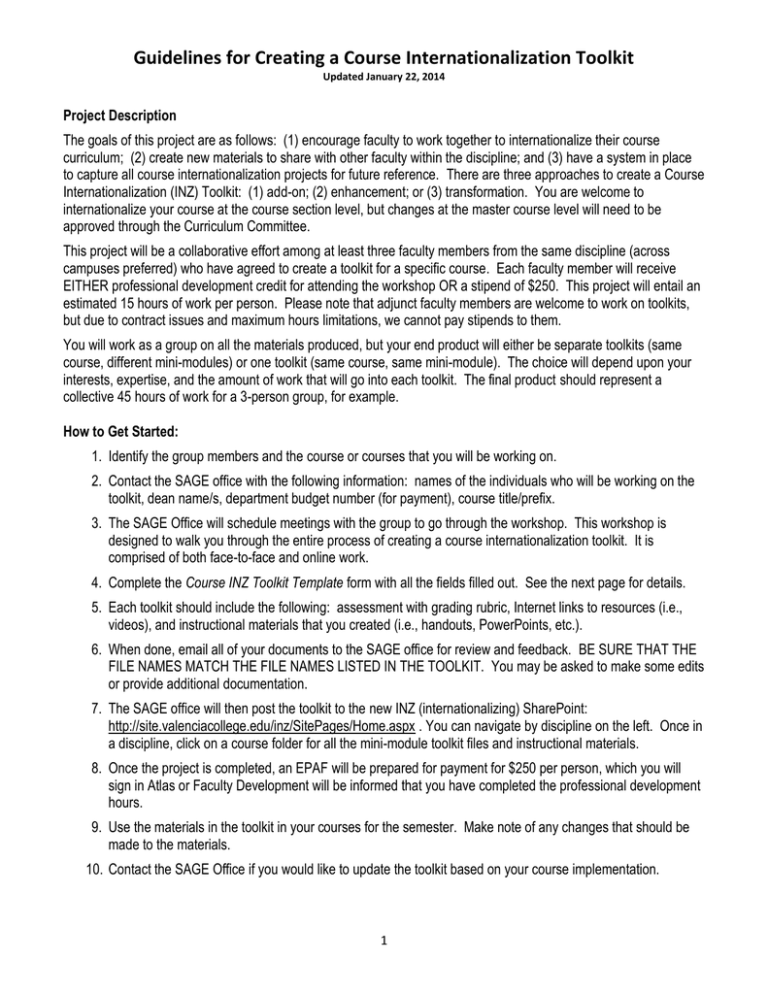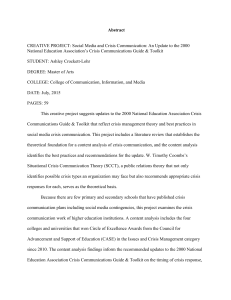Creating a Toolkit Guidelines
advertisement

Guidelines for Creating a Course Internationalization Toolkit Updated January 22, 2014 Project Description The goals of this project are as follows: (1) encourage faculty to work together to internationalize their course curriculum; (2) create new materials to share with other faculty within the discipline; and (3) have a system in place to capture all course internationalization projects for future reference. There are three approaches to create a Course Internationalization (INZ) Toolkit: (1) add-on; (2) enhancement; or (3) transformation. You are welcome to internationalize your course at the course section level, but changes at the master course level will need to be approved through the Curriculum Committee. This project will be a collaborative effort among at least three faculty members from the same discipline (across campuses preferred) who have agreed to create a toolkit for a specific course. Each faculty member will receive EITHER professional development credit for attending the workshop OR a stipend of $250. This project will entail an estimated 15 hours of work per person. Please note that adjunct faculty members are welcome to work on toolkits, but due to contract issues and maximum hours limitations, we cannot pay stipends to them. You will work as a group on all the materials produced, but your end product will either be separate toolkits (same course, different mini-modules) or one toolkit (same course, same mini-module). The choice will depend upon your interests, expertise, and the amount of work that will go into each toolkit. The final product should represent a collective 45 hours of work for a 3-person group, for example. How to Get Started: 1. Identify the group members and the course or courses that you will be working on. 2. Contact the SAGE office with the following information: names of the individuals who will be working on the toolkit, dean name/s, department budget number (for payment), course title/prefix. 3. The SAGE Office will schedule meetings with the group to go through the workshop. This workshop is designed to walk you through the entire process of creating a course internationalization toolkit. It is comprised of both face-to-face and online work. 4. Complete the Course INZ Toolkit Template form with all the fields filled out. See the next page for details. 5. Each toolkit should include the following: assessment with grading rubric, Internet links to resources (i.e., videos), and instructional materials that you created (i.e., handouts, PowerPoints, etc.). 6. When done, email all of your documents to the SAGE office for review and feedback. BE SURE THAT THE FILE NAMES MATCH THE FILE NAMES LISTED IN THE TOOLKIT. You may be asked to make some edits or provide additional documentation. 7. The SAGE office will then post the toolkit to the new INZ (internationalizing) SharePoint: http://site.valenciacollege.edu/inz/SitePages/Home.aspx . You can navigate by discipline on the left. Once in a discipline, click on a course folder for all the mini-module toolkit files and instructional materials. 8. Once the project is completed, an EPAF will be prepared for payment for $250 per person, which you will sign in Atlas or Faculty Development will be informed that you have completed the professional development hours. 9. Use the materials in the toolkit in your courses for the semester. Make note of any changes that should be made to the materials. 10. Contact the SAGE Office if you would like to update the toolkit based on your course implementation. 1 SECTION Name Date Course Prefix & Title INZ Toolkit Entry Name Original Course Learning Outcomes Global Performance Indicators Connections to Global Competencies Teaching Strategies, Student Learning Activities, and Assignments Assessment Method/s and Tools INSTRUCTIONS Enter all of the names of the people who contributed to the toolkit. Enter the date of completion. Enter the complete information. Add a short title for your toolkit that will help identify what it is about. Enter the course learning outcome/s from the OFFICIAL course outline. This can be more than one outcome as long as your project addresses each one. In this section, you are going to either enhance (modify) the existing outcome or add a completing new outcome to the course. These outcomes should be INTERNATIONALIZED in that the wording reflects a link to Valencia’s Competencies of a Global Citizen. You should begin each performance indicator with an action verb to identify what students will be able to do or know upon completion of the learning activities. They must describe a learning result, be specific, be action-orientated, by cognitively appropriate level (remembering, comprehending, applying, analyzing, synthesizing, creating & evaluating), and clearly stated. Refer to the Thesaurus of Verbs Arranged by Cognitive Levels from Bloom’s Taxonomy. Refer to the Competencies of a Global Citizen document. List how the expanded CLO/s connect to the competencies by category: Knowledge, Skills, Attitudes. List all that apply. Remember to think about assessing for the global competencies as well. For example, if you claim that the entry will teach to “values and respects diversity” then it should be clearly connected to the learning activities and assessment methods as well. Only list competencies that are reflected in the learning activities that you add to the document. Use this section to list the strategies and activities that will be done in the classroom or as assignments to help students achieve mastery of the GLO’s. Try to be creative here! Use active learning to fully engage students. Remember that you are writing for another faculty member who will be using your toolkit, so be specific. If you need to identify many steps of a lesson and the information will not fit in the space provided, create a separate lesson plan document and make a reference to it in this section. Identify what the students will do to demonstrate that they have mastered the GLO/s, and identify the tool/s that will be used for grading. Co-Curricular / Interdisciplinary Activities List any outside-of-class activities that will support students’ mastery of the GLO/s such as attendance to a dance concert, museum, Skillshop, festival, guest speaker, etc. You can list activities that are specific to a campus, but do research to see if the activities are offered collegewide and add the details. You must list at least one activity that is not specific to a campus. Activities can be on-campus or off-campus. Instructional Every toolkit should come with instructional materials that are listed in numerical order. The file Materials / Resources names should also include the number. For example: 01 Lesson Plan.doc., 02 PowerPoint.pps, 03 Grading Rubric.pdf, etc. List the documents in the same order as they appear in your lesson. This process will keep the materials organized in the folder on SharePoint. Also, include links to all Internet resources that will be used. 2
